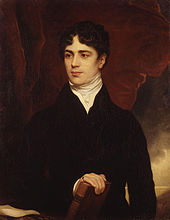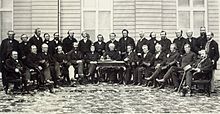Canadian Confederation

The term Canadian Confederation ( English Canadian Confederation , French Confédération canadienne ) describes the events that led to the establishment of the state of Canada (Dominion of Canada) on July 1, 1867 . Four Canadian provinces were formed from three British colonies: The British province of Canada was divided into the new Canadian provinces of Ontario and Québec , and the British colonies of New Brunswick and Nova Scotia became Canadian provinces of the same name.
The term also describes the subsequent expansion to include further provinces and territories in the former British North America . "Confederacy" is often used to describe Canada in an abstract way, an example is " Fathers of Confederation " (English. Fathers of Confederation, fr. Pères de la Confédération ). In Canadian history, a distinction is often made between the time before and after the Confederation.
history
Colonial organization
Before the Confederation in 1867, British North America consisted of six different colonies: Nova Scotia , New Brunswick , the Province of Canada (now Québec and Ontario ), Prince Edward Island , Newfoundland, and the United Colonies of Vancouver Island and British Columbia . The remainder of what is now state territory was made up of Rupert's Land and Northwest Territories , which were controlled by the Hudson's Bay Company and ceded to Canada in 1870, and the Arctic Archipelago , which was under direct British control and came under Canadian ownership in 1880.
Early projects
The idea of a union of all British colonies in North America dates back to 1754 when the Albany Congress was held, twenty years before the first continental congress . At least twelve other association projects followed. However, these did not affect the colonies that were in what is now Canada. In 1839 Lord Durham took up the idea again when he published his " Report on the affairs of British North America ". This report was written in response to the 1837 rebellions .
In 1857, Joseph-Charles Taché proposed a federation in an article in the Courrier du Canada . The politicians Alexander Tilloch Galt , George-Étienne Cartier and John Ross traveled to Great Britain to present the project of a unification of the British colonies to the British Parliament . However, the project met with indifference from the responsible authorities. In 1864, the leading political groups agreed that the provisions of the Act of Union 1840 were too complicated for the effective administration of the Province of Canada to continue. A grand coalition was formed to promote reform of the political system.
negotiations
The future Canadian Prime Minister John Macdonald and other influential politicians encouraged the colonies of New Brunswick, Nova Scotia and Prince Edward Island to send representatives to discuss the introduction of self-government in the form of a unified Dominion . Some leading politicians in the maritime provinces feared that the populous provinces of Ontario and Québec would dominate because of the proposed electoral system and the planned central government.
The first conference was held in Charlottetown in September 1864 . Originally only representatives of the four Atlantic colonies were invited to discuss the creation of an Atlantic Union. On behalf of the Province of Canada, John Macdonald asked for delegates from that colony to attend. During the Charlottetown Conference , Macdonald proposed the unification of all British colonies in North America. Although no binding resolutions were passed, the delegates agreed to hold a second meeting.
At the second conference in the city of Quebec in October 1864, the constitutional basis of the newly formed state was established. At the Québec Conference , New Brunswick and Nova Scotia received the promise that a railway line to Québec should be built (the Intercolonial Railway ). The colonies of Prince Edward Island and Newfoundland decided not to join for the time being. The London Conference in December 1866 concluded the negotiations.
The conference participants decided to designate the new state as the Dominion of Canada . Other proposals such as the Kingdom or Confederation were rejected for various reasons. The term Dominion is attributed to Samuel Leonard Tilley , who is said to have read Psalm 72: 8 of the King James Bible during a morning devotion : (“He shall have Dominion also from sea to sea, and from the river unto the ends of the earth . "). Dominion thus describes the desired expansion of Canada: From ocean to ocean (from sea to sea) and from the St. Lawrence River (from the river) to the North Pole (unto the ends of the earth) .
British America Act 1867
With Queen Victoria's approval of the British North America Act , the legislative process was completed on March 29, 1867. The law that united the province of Canada with the colonies of New Brunswick and Nova Scotia went into effect on July 1, 1867. It replaced the Act of Union 1840, which merged Upper Canada and Lower Canada into the Province of Canada. The new provinces of Ontario and Québec were formed. The 1st of July is today Canada's national holiday (English Canada Day , French Fête du Canada ).
The British North America Act gave Canada significantly more autonomy than before, but the state was nowhere near independent from Great Britain. Foreign policy remained in British hands, the Privy Council's Judicial Commission continued to be the Supreme Court of Appeals, and the constitution could only be changed by the British Parliament. Canada gained more and more autonomy over time and achieved almost complete independence with the Westminster Statute in 1931 . With the Canada Act of 1982, the country also gained constitutional independence. The Canadian Constitution consists of a series of laws and unwritten traditions. The most important is the Constitution Act, 1982 , which in the British North America Act Constitution Act, 1867 (Engl. Constitution Act 1867 , fr. Loi constitutionnelle de 1867 ) renamed.
Fathers of the Confederation
The list above shows those attending the Charlottetown, Québec and London Conferences. These people are also known as the "Fathers of the Confederation".
There were originally 36 Fathers in the Confederation, with Secretary Hewitt Bernard sometimes being added. People who incorporated their respective provinces into the confederation after 1867 are also referred to as such. Such is the case with Amor De Cosmos from British Columbia and Joey Smallwood from Newfoundland.
Joining the Confederation
Further development
After the Manitoba Act was passed by the Canadian Parliament, the new province of Manitoba was created on July 15, 1870 , which was originally much smaller than it is today. British Columbia joined by parliament on July 20, 1871. Above all, the fact that Prime Minister John Macdonald had promised to build a railway line across the entire continent within ten years played a role. Prince Edward Island joined on July 1, 1873, after a ferry service was guaranteed (this provision could be canceled in 1997 after the opening of the Confederation Bridge ).
Canada acquired Rupert's Land from the Hudson's Bay Company in 1869, as well as the Northwest Territory claimed by Great Britain . The formal change of ownership took place on July 15, 1870, when the two territories were combined to form the Northwest Territories . In 1880 Great Britain gave the entire Arctic archipelago to Canada. On June 13, 1898, the Yukon Territory and on September 1, 1905, the provinces of Alberta and Saskatchewan were detached from the Northwest Territories . Newfoundland joined on March 31, 1949 (also after the assurance of a ferry connection). On April 1, 1999, the eastern part of the Northwest Territories became the Nunavut Territory .
Precedence
The list below shows the provinces and territories of Canada in the order in which they joined the Confederation. On formal occasions, the representatives of the provinces and territories take this protocol order of precedence, with provinces always taking precedence over territories. If several provinces joined on the same date, the ranking is based on the number of inhabitants at the time of joining.
| rank | date | Province / Territory |
|---|---|---|
| 1. | July 1, 1867 |
|
| 2. |
|
|
| 3. |
|
|
| 4th |
|
|
| 5. | July 15, 1870 |
|
| 6th | July 20, 1871 |
|
| 7th | July 1, 1873 |
|
| 8th. | September 1, 1905 |
|
| 9. |
|
|
| 10. | March 31, 1949 |
|
| 11. | July 15, 1870 |
|
| 12. | June 13, 1898 |
|
| 13. | April 1, 1999 |
|
Web links
- Information on the Confederation, National Library of Canada and National Archives: engl. , French
- Confederation ( English, French ) In: The Canadian Encyclopedia .
- Confederation / La confédération (English and French)



